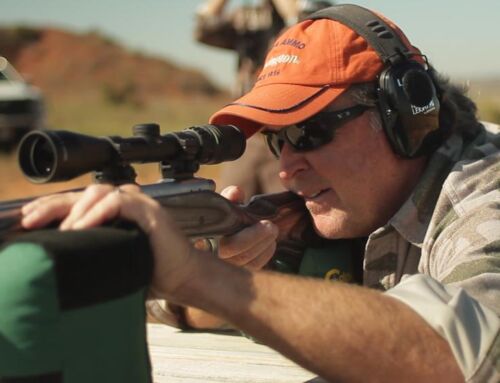 Copper bullets for hunting came onto the scene more than 30 years ago. But since I have been traveling all over the country and shooting lead bullets with great success during that time, felling my share of bucks and a few elk, I never felt the need to go non-lead.
Copper bullets for hunting came onto the scene more than 30 years ago. But since I have been traveling all over the country and shooting lead bullets with great success during that time, felling my share of bucks and a few elk, I never felt the need to go non-lead.
Until last September, when I traveled to the Central Coast of California to hunt for blacktail deer. Doug Roth, my host for this hunt, told me to bring copper bullets, as lead projectiles were prohibited in the area we’d hunt. This was a first for me, but I gladly did so, seeing this as an opportunity to test a different kind of hunting bullet.
On the hunt I carried a Remington Model 783 rifle in .270. In my past experience with the .270, most any brand of 130-grain lead bullet had always proved very accurate. So for my first “copper hunt” I chose the Barnes VOR-TX .270 with 130-grain Tipped TSX (Triple Shock) boat-tail bullet.

Now see the bullet’s blue polymer tip, which serves two purposes. First, it improves the ballistic coefficient of the TSX bullet for better performance at long range. Two, upon impact with a thin-skinned animal (deer), the tip is driven back into the nose, initiating rapid expansion. As the bullet penetrates, the nose peels back into 4 sharp copper petals that basically double the bullet’s diameter to create a wound channel. The nearly 100% weight retention of the copper bullet results in great penetration and tissue damage, since the bullet doesn’t break apart and continues to do damage all way through an animal to the exit wound.
That is what this Barnes bullet is designed to do. So how did it perform for me?
 First, as you can see in this next photo, the 130-grainer shot super accurately in my Remington .270. At .6 inches with two holes touching, this was one of my best 100-yard groups, but I can consistently shoot MOA with this rig on a good day with little wind.
First, as you can see in this next photo, the 130-grainer shot super accurately in my Remington .270. At .6 inches with two holes touching, this was one of my best 100-yard groups, but I can consistently shoot MOA with this rig on a good day with little wind.
 Performance on game: As you will see on TV later this year, the blacktail buck I shot with this bullet was quartering-away, pretty hard. I could not have asked for a better angle for bullet-testing purposes. I aimed back on the last ribs and let the copper pill run three-quarters of the way up and through the animal and vitals, and into the off shoulder. The buck ran 60 yards, maybe, and piled up.
Performance on game: As you will see on TV later this year, the blacktail buck I shot with this bullet was quartering-away, pretty hard. I could not have asked for a better angle for bullet-testing purposes. I aimed back on the last ribs and let the copper pill run three-quarters of the way up and through the animal and vitals, and into the off shoulder. The buck ran 60 yards, maybe, and piled up.
The bullet did not exit, and we found it when we skinned the deer. It had mushroomed nicely to about halfway back the bullet, which made for a “longer” mushroom that I am used to with a lead bullet. But I think this is pretty typical with a hard copper bullet.
On the smaller pig that I drilled at about 120 yards, the bullet blew through the critter noticeably fast and blew up a big cloud of dust on the off side. (A copper bullet is lighter and less dense than lead, and velocities are higher; this Tipped TSX 130-grainer is about 3,060 fps at the muzzle.) So fast was that bullet that it looks like I missed the piggy on TV. But no, it bolted 20 yards and went head over heels in a death roll.
In my limited experience, the Tipped TSX performed wonderfully, both at the range and on game. As we skinned the buck and I found the bullet, I asked my new friend Doug, who has hunted big game across North America with lead bullets for 30 years, and who through his first-rate California guiding business has seen as many animals shot with copper as any man, what he thought.
Given his druthers, I suspect Doug would still use lead. “I will say copper bullets have come a long way,” he says. “The early ones didn’t perform or expand very well. But the newer tipped rounds, like that Barnes you used, are pretty good.”
Some final notes: I look forward to using this copper 130-grainer more this fall, not because I have to, but because it might solve a dilemma for me. I love a lead 130-grainer in the .270 for its accuracy, as mentioned earlier, but oftentimes this bullet does not exit on a good-size buck. It kills deer dead, but with no exit wound, blood trails are non-existent. Bucks can run off and be difficult to find. Sometimes for that reason I go with a heavier 150-grain bullet for .270, but then I give up some velocity and flat trajectory at long range.
I like a hunting bullet that works hard all way through a deer, and then exits with a good-size hole. Copper bullets are noted for their penetration, so the 130-grain Tipped TSX might be just the ticket for me in my .270. I need to try it more on broadside deer to see.
In the end, I am glad I got the chance to hunt with copper bullets and I will do it again. The Barnes VOR-TX with Tipped TSX Bullet is available in some 20 calibers suitable for deer hunting, from .22-250 to .300 Win Mag. Best price I found on the Web was $41.99 for a box of 20 cartridges.
UPDATE May 6, 2015: California will require the use of lead-free hunting ammunition state-wide by July 1, 2019. And know this now: Non-lead ammo will be required for all hunting on CDFW state lands beginning with the 2015 season!







Funny, they could take guns AND bows away completely and I’d still be giddy chasing them with a spear and knife…so lead bullets don’t concern me terribly knowing Barnes has us covered.
Mike, my son Zach’s first buck that you posted almost six years ago fell after 50 or so yards compliments of a 130 grain TTSX from a Federal Premium round screaming at 3,500 fpm from the muzzle of his .300 Win Mag Encore. For a high lung shot at 160yds, it was decisive. My gut tells me the velocity helped at the expense of excess bloodshot meat, but for his first buck I was ok with it. Don’t have a good feel for expansion in slower load. I neck shot a smaller buck with same cartridge with similar results in somersaulting deer at end of run. Felled a hefty muley at 75 yds in a heart shot going no more than 50 yds and a pass through. In a .270 I think you’ll need no other bullet for any animal. I love the .270 btw, have one in a T/C Venture.
California is trying to pass a no lead bullet ban on hunting right now. Soon it may be law. That drives up the cost of ammo and will discourage many from hunting period. Then I’m sure other states will jump on the no lead bandwagon and make the same laws. It is more about anti-hunting than it is about the environment. If they can’t outlaw the guns, then they will go after the ammunition and this is the first step. I have been hoarding ammo for the last three years because I’ve seen it coming. Ammo prices have risen and will continue to rise. Case in point is the .22 round, who would have ever guessed. Ammo will be about like silver and gold maybe one day real soon. One instance of an EMP, financial unrest, civil disobedience, earth quake, massive volcano, atomic bomb, etc. and ammo will be like gold. The survivalist in me says, stock up on ammo now, it will be a worthy investment in the future whether you have to use it to hunt for food, protect your family or sell it to those that didn’t prepare.
Been shooting Barnes since 2009 in my .325 WSM. 180 gr Triple Shock (not tipped). Killed my Colorado 170 inch muley at 333 yrds. He was slightly quartering away. Bullet went through the lungs and lodged in the far shoulder. He nose dived on impact and “snow plowed” for maybe 10 yrds. Retrieved the bullet and it was exactly how you described above. Have killed several whitetails back home at long range with it. Has performed flawless to this point. Still shoot lead out of my 30-06 and .35 Rem.
Thanks great info Danny. Yes, they build the Triple Shock (not tipped) for big stuff like elk for the penetration, and the Tipped bullet helps for fast expansion on thin-skinned game, which means they build it for deer hunters